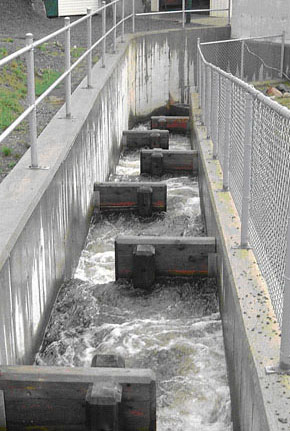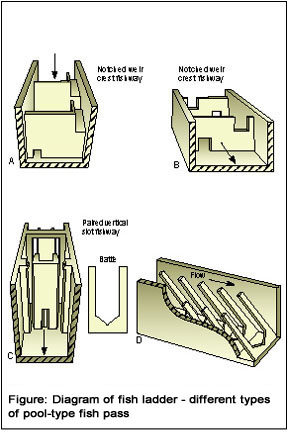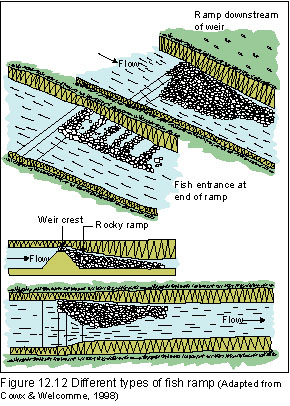Restoration
of Longitudinal Connectivity--
Structures for the restoration of fish movements around dams and other
obstructions are the most common method for rehabilitation of rivers.
In most countries of the world, the law obliges those constructing dams
and weirs to make provision for the fish to move past the obstacle. As
with other mitigation measures, it is much more effective, both for cost
and for efficiency of construction, that the fish pass is included in
the planning and costing of the original dam structure, rather than to
install one later. The obligation to build fish passes of some kind has
led to a large number of structures being constructed that are not adapted
to the fish populations that are present (e.g., the case of the Pak Mun
Dam fish ladder). Most types of traditional fish pass are exclusive in
that they do not allow other forms of animal life to pass upstream. This
section examines the various types of fish pass currently available for
their cost and effectiveness.
Fish Ladders
Fish ladders consist of a series of chambers or pools separated by plates.
This produces a series of steps up, past which some fish species can migrate.
 |
 |
There are four main types of fish pass:
The pool pass, in which each plate has an opening, either at the top or the bottom, through which the water passes. Pool passes are suitable for low to medium heads (i.e., dam heights) with moderate flows. They are effective for actively migrating fish that are able to jump over the plates or pass through the openings. They are less suitable for small weakly swimming species and for invertebrates.
The slot pass, in which the water passes through one or two slots that reach to the bottom of the pass. This design is the most satisfactory as even small, weak swimmers can negotiate the pass.
The Denil pass, in which the plates have a U-shaped opening and are mounted at an angle to the vertical axis of the pass. Denil passes are very effective under high flows but can only be used successfully by the largest, most energetic fish. They have the further disadvantage that they cannot fold back on themselves, as can other types of fish ladder. Instead they have intermediate resting pools where a high obstacle has to be passed.
The rhomboid pass, where the plates are mounted at an angle to the longitudinal axis of the pass. Rhomboid passes perform rather like Denil passes, but can be folded.
Fish Ramps
Fish ramps substitute the hard engineering of the fish pass by a softer
approach using natural materials such as rocks and gravel. They use large
boulders and lines of stones to break up the flow and create pool-like
resting places for the fish. Fish ramps appear more natural than fish
ladders but they occupy a lot more space, as they may take up to the full
width of the river. Narrower ramps are also used and stretch for some
distance downstream of the obstacle. Most fish and a number of invertebrate
species are able to move both upstream and downstream using fish ramps.
Biocanals
Biocanals are long channels that completely by-pass the obstacle. They
originate above the headwaters of the reservoir and discharge below the
dam. They have the advantage that the difference in height is dissipated
over a long distance, so they have shallow slope negotiable by all aquatic
life forms. They even may develop their own populations of fish. The disadvantage
of biocanals is the space they require, and the cost of excavating a channel
that may be several kilometres long. They can, however, be a valuable
and natural looking resource.
 |